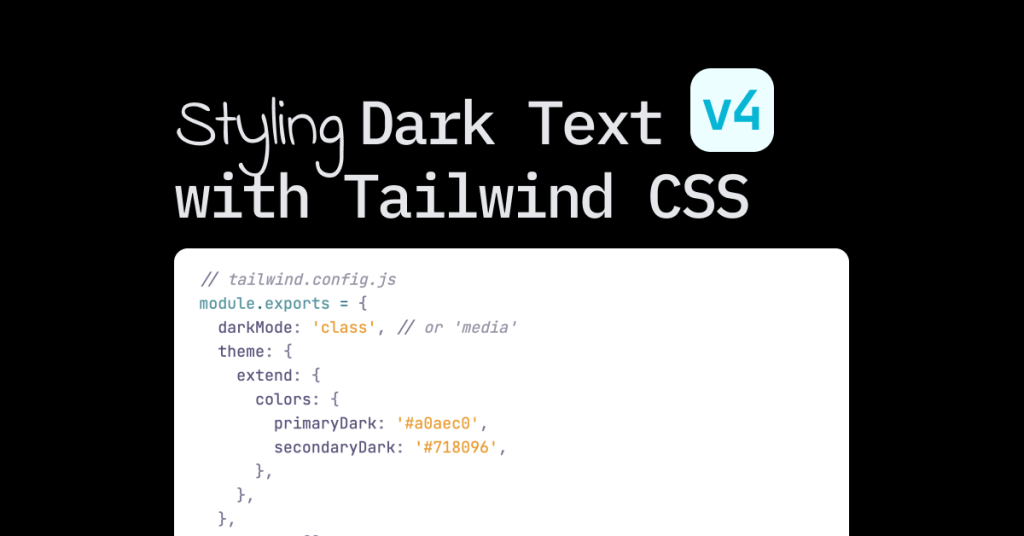Tailwind CSS: Styling Dark Text Easily [v4]
Create high-contrast dark text designs

In today's web design landscape, dark mode isn’t just a trend—it’s a necessity. Not only does it offer an eye-friendly alternative to light themes, but it also gives your website a modern, sleek vibe that many users love. In this post, we’ll dive deep into how you can use Tailwind CSS v4 to style dark text effortlessly.
What Is Tailwind CSS v4 and Why Dark Mode Matters
Tailwind CSS has revolutionized the way developers approach styling by introducing a utility-first approach. This means instead of writing custom CSS for every element, you use pre-built classes to handle layout, spacing, typography, and much more. With the release of version 4, Tailwind continues to push boundaries by making it even easier to implement responsive and dynamic design patterns.
Dark mode is more than just a different color palette. It improves accessibility, reduces eye strain in low-light environments, and can even help your site save energy on OLED screens. In Tailwind CSS v4, handling dark mode becomes straightforward thanks to the built-in dark: variant.
Enabling Dark Mode in Tailwind CSS v4
Before you can style dark text, you need to enable dark mode in your Tailwind CSS configuration. Tailwind CSS supports two main strategies for dark mode: the media strategy and the selector strategy.
Media Strategy vs. Selector Strategy
Media Strategy:
This method uses the user’s operating system preferences by leveraging the
prefers-color-schememedia feature. It automatically applies dark mode styles if the user has enabled dark mode on their device.Selector Strategy:
With the selector strategy, dark mode is controlled by a specific class (usually
dark) added to an element (often the<html>or<body>tag). This approach gives you full control over when dark mode is applied, making it ideal for implementing theme toggles.
For Tailwind CSS v4, you can set your preferred method in your tailwind.config.js file. For example:
// tailwind.config.js
module.exports = {
darkMode: 'media', // or 'class'
content: [
'./src/**/*.{html,js,jsx,ts,tsx}',
],
theme: {
extend: {},
},
plugins: [],
};Using the media strategy is as simple as that—Tailwind will automatically switch to dark mode based on the user's system settings. If you choose the selector strategy, make sure you add the dark class to your HTML element when you want dark mode active.
Styling Dark Text with Tailwind
Once dark mode is enabled, styling dark text becomes a breeze. The key is the dark: variant, which allows you to specify styles that should only apply when dark mode is active.
Basic Syntax
Here’s a simple example of using the dark: variant to change the text color:
<h1 class="text-gray-900 dark:text-gray-100">
Welcome to My Website
</h1>In this snippet, the heading will display with a dark gray color in light mode (text-gray-900). When dark mode is active, it switches to a lighter gray (dark:text-gray-100), ensuring that the text remains legible against a dark background.
Best Practices for Dark Text Styling
Contrast is Key:
Always ensure that your text color contrasts sufficiently with the background color. For dark mode, this typically means using lighter colors for text. Tailwind offers a wide range of shades to help you achieve the right balance.
Consistent Typography:
Use the same font families and sizes in both light and dark modes. The only change should be the color to maintain consistency in your design.
Testing on Multiple Devices:
Because dark mode can appear differently on various screens, test your color choices on multiple devices to ensure readability.
Accessibility Considerations:
Aim for a contrast ratio that meets accessibility standards (WCAG). Tailwind’s color palette is designed to help, but it never hurts to double-check with tools like the WebAIM contrast checker.
Step-by-Step Guide: Creating a Dark Mode Toggle
If you’re using the selector strategy, you’ll likely want a way for users to toggle dark mode on and off. Here’s a simple example of how you can implement this using JavaScript and Tailwind CSS.
1. Update Your HTML
First, set up your HTML to include a button for toggling the theme:
<!DOCTYPE html>
<html lang="en" class="scroll-smooth">
<head>
<meta charset="UTF-8">
<meta name="viewport" content="width=device-width, initial-scale=1.0">
<title>Tailwind CSS: Styling Dark Text Easily</title>
<link href="/dist/output.css" rel="stylesheet">
</head>
<body class="bg-white dark:bg-gray-900">
<header class="p-4">
<button id="theme-toggle" class="px-4 py-2 bg-blue-600 text-white rounded">
Toggle Dark Mode
</button>
</header>
<main class="p-8">
<h1 class="text-3xl font-bold text-gray-900 dark:text-gray-100">
Welcome to the Dark Mode Demo
</h1>
<p class="mt-4 text-gray-800 dark:text-gray-300">
This is a sample paragraph to show how dark text styling can enhance readability.
</p>
</main>
<script src="/js/theme-toggle.js"></script>
</body>
</html>2. Implement the Toggle Logic
Create a simple JavaScript file (theme-toggle.js) to handle the theme switch:
const themeToggleButton = document.getElementById('theme-toggle');
themeToggleButton.addEventListener('click', () => {
document.documentElement.classList.toggle('dark');
// Optional: Persist the theme choice using local storage
if (document.documentElement.classList.contains('dark')) {
localStorage.setItem('theme', 'dark');
} else {
localStorage.setItem('theme', 'light');
}
});
// On page load, set the theme based on local storage if available
if (localStorage.getItem('theme') === 'dark') {
document.documentElement.classList.add('dark');
} else if (localStorage.getItem('theme') === 'light') {
document.documentElement.classList.remove('dark');
}With this setup, users can toggle dark mode on and off. The text colors switch automatically, ensuring that your dark text styles are applied for optimal readability.
Advanced Customizations for Dark Text
Tailwind CSS v4 offers even more customization options to make your dark mode styling truly shine. Let’s explore some advanced techniques you can use.
Customizing Color Palettes
Sometimes, the default color palette might not perfectly fit your design. Tailwind allows you to extend the color palette in your configuration file:
// tailwind.config.js
module.exports = {
darkMode: 'class', // or 'media'
theme: {
extend: {
colors: {
primaryDark: '#a0aec0',
secondaryDark: '#718096',
},
},
},
plugins: [],
};Now you can use these custom colors in your classes:
<p class="text-primaryDark dark:text-secondaryDark">
This paragraph uses custom dark mode colors.
</p>Responsive Dark Mode
Tailwind makes it easy to combine responsive design with dark mode. For instance, you can specify different text sizes for various screen sizes while also defining dark mode text colors:
<h1 class="text-xl md:text-3xl lg:text-4xl text-gray-900 dark:text-gray-100">
Responsive Dark Text Heading
</h1>This ensures that your typography is not only adaptable to different devices but also optimized for both light and dark modes.
Combining State Variants with Dark Mode
You can also blend state variants like hover or focus with dark mode styling. This adds an extra layer of interactivity to your design:
<a href="#" class="text-gray-900 dark:text-gray-100 hover:text-blue-600 dark:hover:text-blue-300">
Hover over me for a color change!
</a>When users hover over the link, the text color transitions smoothly to a blue shade, with the dark mode variant ensuring consistency in appearance.
Practical Use Cases and Real-World Examples
Let’s explore some scenarios where styling dark text can greatly improve your website’s user experience.
Blog and Content Websites
For blogs and content-heavy sites, readability is paramount. When dark mode is enabled, the background typically turns dark, so you need to ensure that your text remains clear and legible. Using Tailwind CSS, you can set up your blog’s typography like this:
<article class="prose dark:prose-invert">
<h1>Dark Mode in Action</h1>
<p>
Enjoy a visually appealing reading experience whether you're using dark or light mode.
</p>
</article>The prose class from Tailwind Typography is optimized for readable content. When combined with the dark:prose-invert variant, it automatically adjusts the text color and other typography elements for dark mode.
E-Commerce Sites
Imagine an e-commerce site where products are showcased in a modern, dark-themed layout. Dark text styling becomes critical for highlighting product names, prices, and descriptions against a dark background. Here’s how you can achieve that:
<div class="bg-gray-800 p-6 rounded-lg">
<h2 class="text-2xl font-semibold text-gray-100">
Modern Lamp
</h2>
<p class="mt-2 text-gray-300">
A sleek, contemporary lamp perfect for any modern home.
</p>
<span class="block mt-4 text-xl font-bold text-green-400">
$129.99
</span>
</div>In this example, the contrasting light text colors ensure that important product information stands out even on a dark background.
Dashboard and Admin Interfaces
Dark mode is a popular choice for dashboard interfaces, where users spend extended periods monitoring data and interacting with controls. Tailwind CSS enables you to design dashboards with optimized dark text that is easy on the eyes:
<div class="min-h-screen bg-gray-900 p-8">
<header class="mb-8">
<h1 class="text-3xl font-bold text-gray-100">
Dashboard
</h1>
</header>
<section>
<p class="text-lg text-gray-300">
Monitor your site’s performance and view detailed analytics.
</p>
</section>
</div>Using classes like text-gray-100 and text-gray-300 ensures that your dashboard remains visually appealing and readable, even after long hours of use.
Accessibility and Dark Mode
While styling dark text, it’s essential to keep accessibility in mind. Here are a few tips to ensure your dark mode design is accessible to everyone:
Maintain High Contrast:
Ensure that your text stands out against the background. Tailwind CSS’s extensive color palette can help you choose the right shades for optimal contrast.
Test with Screen Readers:
Verify that your design works well with assistive technologies. Proper contrast and legible text are key for users with visual impairments.
Avoid Overusing Effects:
While subtle animations and hover effects add interactivity, make sure they don’t interfere with readability or create distractions in dark mode.
Responsive Design:
Always test your dark mode design on different devices and screen sizes to ensure consistency and readability across the board.
Performance Considerations
One of the major advantages of using Tailwind CSS is its efficiency. Tailwind’s JIT (Just-In-Time) mode compiles only the styles you use, which means your CSS files remain small and performant. Here are some tips to keep your dark mode implementation lean:
Purge Unused Styles:
Tailwind CSS’s purge functionality ensures that any styles not used in your project are removed from your final CSS bundle.
Use the JIT Compiler:
With Tailwind v4, the JIT compiler is more powerful than ever. It only generates the classes you actually use, making it easier to manage dark mode variants without bloating your CSS.
Minimize Custom CSS:
Rely on Tailwind’s utility classes as much as possible. This keeps your codebase maintainable and ensures that your styles are optimized for performance.
Integrating with JavaScript Frameworks
Tailwind CSS works seamlessly with popular JavaScript frameworks like React, Vue, and Angular. When you add dark mode toggles in these frameworks, the process is very similar to the vanilla JavaScript example we covered earlier.
For instance, in a React component, you might implement a dark mode toggle like this:
import { useEffect, useState } from 'react';
function DarkModeToggle() {
const [isDark, setIsDark] = useState(false);
useEffect(() => {
const storedTheme = localStorage.getItem('theme');
if (storedTheme === 'dark') {
document.documentElement.classList.add('dark');
setIsDark(true);
}
}, []);
const toggleTheme = () => {
if (isDark) {
document.documentElement.classList.remove('dark');
localStorage.setItem('theme', 'light');
} else {
document.documentElement.classList.add('dark');
localStorage.setItem('theme', 'dark');
}
setIsDark(!isDark);
};
return (
<button onClick={toggleTheme} className="px-4 py-2 bg-blue-600 text-white rounded">
{isDark ? 'Switch to Light Mode' : 'Switch to Dark Mode'}
</button>
);
}
export default DarkModeToggle;This snippet shows how easily you can integrate dark mode toggling into a React component, making your application interactive and user-friendly.
Conclusion
Dark mode is more than a design preference—it’s a fundamental aspect of modern web design that enhances usability, reduces eye strain, and brings a touch of sophistication to your projects. With Tailwind CSS v4, styling dark text is as simple as applying a few utility classes.

Yucel is a digital product creator and content writer with a knack for full-stack development. He loves blending technical know-how with engaging storytelling to build practical, user-friendly solutions. When he's not coding or writing, you'll likely find him exploring new tech trends or getting inspired by nature.